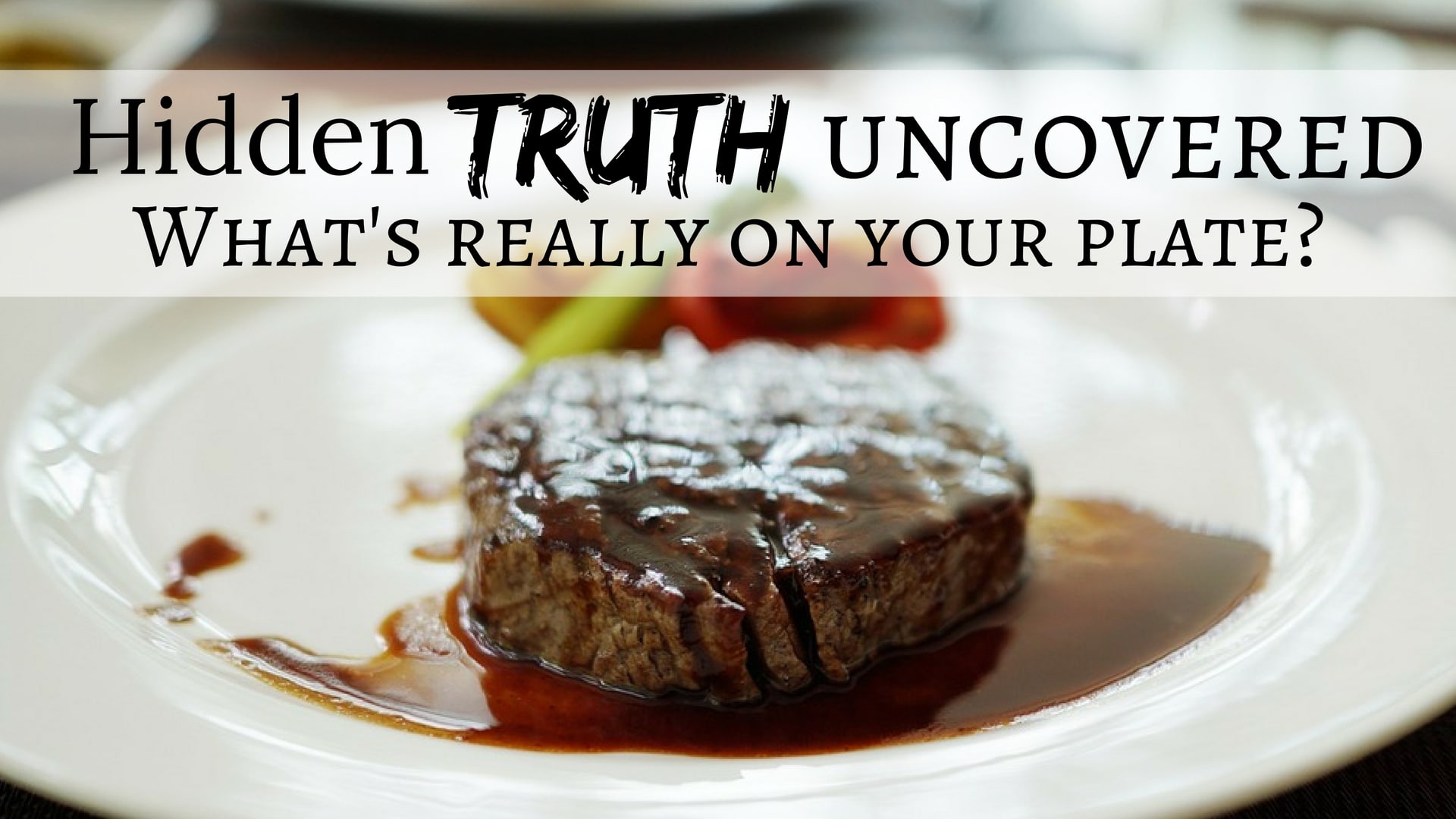What’s on your Plate?
What's on your Plate?

The increase in health and nutrition knowledge over the past decade has given rise to a new generation of health conscious individuals. They're concerned about the nutritious value of the foods they buy, the impact that the foods will have on their body, and even the impact their foods will have on the environment. These are all factors we should be concerned about as it relates to the foods we consume. But, should we really be concerned about what we eat?
Consider red meat. As part of a balanced diet and healthy lifestyle, red meat is an important source of several key nutrients. Historically, up to the 1940's, most beef was produced from cattle that were fed grass. However, by the 1950's things changed dramatically. In an effort to "improve the efficiency" of beef production, the industry changed its feeding and farming practices.
Beef production became industrialized. Cattle were put in feedlots and fed high-energy, high-sugar grains. This diet meant less days on grass, more fat and marbling in the meat, and cheaper production costs.
These production practices are so rampant now that the average American consumer is more accustomed to the taste of grain-fed beef and generally unfamiliar with the taste of grass-fed beef. 1
While most Americans are loyal to their grain-fed beef, there has been a surge in consumer demand for grass-fed beef produced with the earlier, pastoral approach. In the end, does it really matter what the animal was fed?
What do you think? Some say that meat is meat and beef is beef - it doesn't matter where the meat comes from.
However, science and logic help us to understand that just isn't true. Much like the human body, an animal's diet, lifestyle, and environment can influence its health, nutrition, and even the nutritional content of its products. Yes, an animal's diet and lifestyle affects you.
GRASS-FED & GRAIN-FED DEFINED
In general, all beef cattle start out on pastures or rangelands for the first few months of life, eating grass or other edible plants. Things quickly change, though, depending on the practices of the farm.
Grain-fed
How is the most widely produced type of beef made?
At around 6-12 months of age, the cows are moved to feedlots to be "finished." They are fed a high-energy diet usually based on processed grains (either corn or soy). The final 4-6 months of their lives are spent confined to pens with about 125-150 feet of space. At this point, they are no longer allowed to graze on grass. This diet is used to boost productivity and weight gain and keep production costs low. 2
This isn't your typical farm because mass farming practices are used. Cattle spend a significant part of their lives crowded in feedlots with hundreds or even thousands of other animals. Can their immunity remain strong in these unsanitary living conditions and diet of cheap, high-sugar grains, factory scrap, and sometimes even processed vegetable oils? Rarely, if ever. While pasture-fed animals rarely get sick, cattle confined to feedlots need routine antibiotics to prevent illness. Synthetic hormones and antibiotics are also used as a shortcut to quicker growth.
What can be said of their diet? The effects of a processed food diet on an animal is quite similar to the effects of a processed food diet on you. The fields they get their grains from abound in herbicides, pesticides, and even hormones.
Their digestive systems are also stressed and damaged. A cow's digestive system is designed to digest grass. Although grains may fatten a cattle up, it can seriously damage its digestive system and weaken its immunity. What's the solution? More antibiotics.
What does grass-fed beef production look like?
With grass-fed beef, cows and calves continue to live, roam and graze on fresh pasture grass and herbs for their entire life. Instead of relocating to a feedlot, they are simply rotated to different pastures so that their diet includes a variety of different plants. Their grass-fed diets may be supplemented with hay during winter months, although some cattle can graze year-round. Their natural diet and healthy environment keeps their immune system strong and they are less prone to disease and sickness. 3
As a plus, this practice also protects the pasture land from overgrazing and stimulates plant diversity. Grass-fed cattle raisers report that hundreds of different species of plants and grasses that have been stripped away due to conventional farming have returned. Many have seen an increase in the diversity of animals, insects, and birds native to their area.
This method is obviously not as efficient. The calves don't "finish" or fatten up quickly. Grass-fed farmers may have to wait a bit longer for their cattle to grow for slaughtering. Still, the treatment of their animals doesn't only relate to their ability to be sold. They consider the health of the animal and of its environment.
Which production site would you like to get your beef from? A farm that raises healthy animals naturally and contributes to a healthy environment or one that does the complete opposite?
Which industry would you rather buy from and support - one that focuses on quantity and profit or on quality and sustainability?
DIGGING DEEPER
The differences between grass-fed and grain-fed beef extend far beyond just the farming practices.
Over the past three decades, we have accumulated a body of evidence pointing to the dramatic difference between grass-fed and grain-fed (or what is now considered to be conventionally raised) beef.
Regardless of what the cow is fed, red meat is an important source of several nutrients, including essential amino acids, vitamins A, B6, B12, D, E, iron, zinc, and selenium. 4 Red meat also provides a number of different saturated fatty acids that aid in the absorption of fat-soluble vitamins A, D, E, and K.
Diet changes the meat, however, and a healthy diet can improve it. 5 In fact, regardless of the gender, age, species, genetic makeup, and geographic location of the cattle, there are distant and dramatic differences between the overall nutrition profiles of grass- and grain-fed portions of beef.
ESSENTIAL FATTY ACIDS:
The number one reason why grass-fed beef is nutritionally superior to grain-fed beef is the consistent finding that grass-fed cows have greater levels of omega 3 fatty acids. 6 Grass is 60% omega-3. What else would you expect from a cow that feeds on fresh pasture grass with no additives its whole life?
Omega 3 plays a unique and important role in heart health, joint health, fighting cancer, bone health, fighting depression, and brain health.
Not only are most Americans deficient in omega-3 fats but they are also consuming too much omega-6 fats. A healthy diet consists of around 1-4 times more omega-6 fatty acids than omega-3. Where does the typical American diet stand? Most American diets contain 11-30 times more omega-6 than omega-3 fats.
Aren't they both essential? Yes they are. However, they need to be consumed in a balanced ratio. What happens when the ratio is unbalanced? Remember, omega-6 is a pro-inflammatory fatty acid. Too much omega-6 creates an inflammatory environment. Did you know that most chronic diseases find their roots in inflammation? 7
Also, both omega-6 and omega-3 use the same enzymes for metabolism. If omega-6 continues to dominate over omega-3 in the majority of American diets, which fatty acid do you think will win the enzymes? Yes, omega-6 usually wins. We can't expect to benefit from the omega-3 we consume if we crowd it with omega-6 fats that are more dominant.
The British Journal of Nutrition published a recent 4-week study that followed healthy individuals who consumed three weekly portions of red meat from either grass- or grain-finished animals. The levels of oemga-3 in blood were significantly higher in those who consumed grass-fed red meat compared with grain-fed eaters. 8
Clearly, grass-fed beef is a healthy way to prevent deficiency of omega-3 fatty acids, which is presently a nationwide problem.
SATURATED FATTY ACIDS:
When it comes to saturated fatty acids, not all are equal. Some have a neutral effect on blood cholesterol levels while others can have a detrimental effect. Grain-fed beef is higher in myristic and palmitic acids - two saturated fatty acids found to be more detrimental to blood cholesterol levels.
Grass-finished meat contains the highest concentrations of stearic acid, a saturated fatty acid that has a neutral impact on serum cholesterol. 9
As a result, grass-fed meat tends to produce a more favorable saturated fatty acid composition. Which type of meat would help to prevent toxicity in your body?
CAROTENOID CONTENT:
Carotenoids are a family of compounds found in plants as natural plant pigments of yellow, orange, and red. What can be said of cattle that grazes extensively on grass and other plants? Animals that graze on carotenoid-rich plants pass most carotenoids into their body fat and milk. In fact, if you've ever seen grass-fed beef, you'll notice that its carcass fat has a richer yellow color than grain-fed beef. This rich yellow color comes from the carotenoids of lush green plants.
Carotenoids are used for the production of vitamin A - a critical nutrient for normal vision, bone growth, reproduction, and cell division. 10, 11 Vitamin A is responsible for maintaining a healthy intestinal, respiratory, and urinary tract. It also supports immune strength through the production and function of white blood cells.
ANTIOXIDANT CONTENT:
The fat and muscle tissues of grass-fed beef also have greater concentrations of vitamin E, a powerful antioxidant that comes in 8 different forms. Multiple studies have shown that cattle finished on grass have higher levels of the most active form of vitamin E - alpha tocopherol. 12, 13
Feeding cows grass increases their alpha-tocopherol levels three times more than grain-fed beef. Animal Sciences Research Report. The Department of Animal Sciences, Colorado State University; 2002. Ref Type: Report.
Finally, another important antioxidant found in grass-fed beef is glutathione. This is the mother of all antioxidants that reduces free radicals and protects DNA. Not only does this antioxidant protect the meat itself from oxidation but it can serve as an additional source of antioxidants for the consumer. 14
Choose Your Meat Wisely - It COW-nts
As health conscious individuals, we strive to consume an antioxidant-rich, nutrient-dense, balanced, healthy diet. We strive to avoid processed ingredients, artificial ingredients, any unnecessary exposure to toxicity from antibiotics or synthetic ingredients that can harm our immune system, digestive system, and the health of all other body systems.
Why shouldn't our meat come from animals that do the same?
A grass-fed cow is fed an antioxidant-rich, balanced, immunity-strengthening, nutrient-dense, balanced diet rich in vitamin E, carotenoids, omega-3 fatty acids, and other important nutrients. It isn't fattened up by an energy-dense diet loaded with processed grains and questionable additives and injections.
Yes, we are what we eat. Also, we are what the food that we eat once ate.
Choose pasture-fed, hormone and antibiotic-free beef. When you do so, you're choosing pure food and nutrients that your body needs from meat produced the way it was meant to be produced.
You will most likely be supporting your local economy. Grass-fed farming reduces the need for mass transportation of meat. This helps to support and maintain a relationship with a local business or farm that uses sustainable and humane practices.
You will know what's on your plate. You will know what's not on your plate - questionable additives, synthetic hormones and antibiotics, GMO's, and other toxins that can interfere with your body's normal functions.
The benefits reach beyond taste and nutrition. Grass-fed farming doesn't burden the environment. It doesn't deplete the soil or modify it but instead helps to build it.
References
- Meat Science. 2003; 66:21–32. doi: 10.1016/S0309-1740(03)00022-6.
- http://www.ncga.com/uploads/useruploads/corn-fedgrass-fedbeef.pdf
- http://www.ams.usda.gov/grades-standards/beef/grassfed
- Meat Science. 2005; 70(3):509–24. doi: 10.1016/j.meatsci.2004.07.017.
- Meat Science. 2009; 82:331–7. doi: 10.1016/j.meatsci.2009.02.002.
- Meat Sci. 2014 Jan; 96(1):353-60. doi: 10.1016/j.meatsci.2013.07.021.
- Nutr Clin Pract. 2010; 25(6):634-640.
- Br J Nutr. 2011 Jan; 105(1):80-9. doi: 10.1017/S0007114510003090.
- Nutr J. 2010; 9: 10. Published online 2010 Mar 10. doi: 10.1186/1475-2891-9-10
- Acta Ophthalmologica Scandinavica. 1997; 75:634–40. doi: 10.1111/j.1600-0420.1997.tb00620.x
- National Institute of Health Clinical Nutrition Center. Facts about dietary supplements: Vitamin A and Carotenoids. 2002. Ref Type: Pamphlet.
- Journal of Meat Science. 2005; 70:35–44. doi: 10.1016/j.meatsci.2004.11.018.
- Meat Science. 2002; 60(1):35–40. doi: 10.1016/S0309-1740(01)00102-4.
- Meat Science. 2007; 75:299–307. doi: 10.1016/j.meatsci.2006.07.015.
OFFICE HOURS
Monday
9:00am - 11:00am
3:00pm - 6:00pm
Tuesday
5:30pm - 6:30pm
Wednesday
9:00am - 11:00am
3:00pm - 6:00pm
Thursday
9:00am - 11:00am
3:00pm - 6:00pm
Friday
Closed
Saturday
Closed
Vilulu
2051 Reed Road Suite B
Fort Wayne, IN 46815
(855) 784-5858


